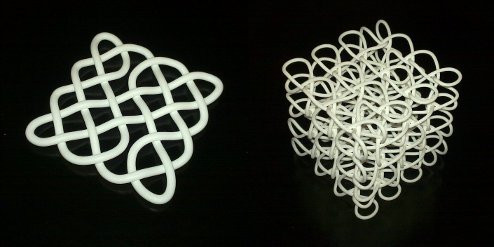List items
Items from the current list are shown below.
Blog
12 Feb 2012 : Celtic Knots: moving from 2D to 3D #
A couple more prints have arrived from Shapeways and once again I'm really pleased with the results. The first was a bit of an experimental print for a number of reasons. It's another 3D Celtic knot, but this time I tried it with much thinner threads, right down to the minimum of 0.7mm thickness recommended by Shapeways. I get the feeling this recommendation is intended for walls, so I'd feared the threads wouldn't be strong enough to hold together. In fact, the final result is perfectly sturdy and the threads seem quite robust. Second, I tried the polished version of the "white strong and flexible" material (which is apparently a kind of nylon). The polishing process involves shaking the model with lots of tiny polishing balls, so again I'd feared this might affect the models strength. And again, it seems my fears were unfounded. Finally, I generated the model to have gaps where the threads cross over, the hope being it would be printed in four separate pieces. Unfortunately I apparently didn't give enough clearance, and some of the threads fuse at these intersections. Nonetheless, some of them are still loose, and the result is really great. I may try it again with a bit more of a gap next time though.

The second knot is a proper 2D Celtic knot. The idea is that this is generated from the same seed as the 3D knot, making it in some sense the 'same' knot. That's not really true, but until I figure out what's really meant by 'the same', this is as close as I can think of. I was pleased to find that, since they're both printed with the same dimensions, resting the 2D version on one of the faces of the 3D knot, they align nicely and really look like one is an extruded version of the other.
Once again, printing out these knots has provided some really nice results, leaving the biggest problem the question of what to print next.

The second knot is a proper 2D Celtic knot. The idea is that this is generated from the same seed as the 3D knot, making it in some sense the 'same' knot. That's not really true, but until I figure out what's really meant by 'the same', this is as close as I can think of. I was pleased to find that, since they're both printed with the same dimensions, resting the 2D version on one of the faces of the 3D knot, they align nicely and really look like one is an extruded version of the other.
Once again, printing out these knots has provided some really nice results, leaving the biggest problem the question of what to print next.